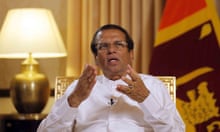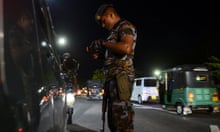Islamic State has claimed responsibility for the Easter bombings in Sri Lanka that killed more than 320 people, the group’s Amaq news agency has said, with experts saying the attacks bear the hallmarks of the group.
It is the deadliest overseas operation claimed by Isis since it proclaimed its “caliphate” almost five years ago, and would suggest it retains the ability to launch devastating strikes around the world despite multiple defeats in the Middle East.
The group published a statement saying its “fighters” were responsible for the attack and listing the names of the suicide bombers, who were also shown in a video swearing allegiance.
Experts said that although Isis had made false claims of responsibility in the past, it appeared likely that its involvement in the suicide bombings of three churches and three luxury hotels on Sunday would be confirmed by ongoing investigations.
The claim from Isis came as Sri Lankan authorities were put under further pressure by reports that they had received repeated warnings from Indian intelligence services about a potential suicide attack against churches.
A Sri Lankan defence official told Reuters news agency that a warning was sent by Indian officials on Saturday night. An Indian government source said similar messages had been given to Sri Lankan intelligence agents on 4 April and 20 April.

Sri Lanka’s prime minister, Ranil Wickremesinghe, said on Tuesday that there were more explosives and militants “out there”, and acknowledged there had been a prior warning about potential attacks. Some officials would likely lose their jobs over intelligence lapses, he said.
Wickremesinghe also revealed there had been a failed attack against a fourth major hotel, and that the Indian embassy was also a possible target.
More than 40 people have been arrested as part of investigations into the attack, which has shaken the fragile stability of Sri Lanka and recalled the worst days of its brutal decades-long civil war.
The military have been granted emergency powers, allowing them to conduct searches without warrants and detain suspects for up to two weeks without a court hearing. Such powers have not been issued since the war, which ended a decade ago.
Isis has also released a photograph of an Islamic cleric from eastern Sri Lanka who has been identified as the leader of the attacks. Mohammed Zahran, also known as Zahran Hashmi, became known to Muslim community leaders three years ago for his incendiary speeches online. Several members of the community attempted to inform security services of the threat they believed Zahran and his followers in the National Towheed Jamaat group posed.
The group has not issued the real names of the suicide bombers, nor specified their nationalities. Investigators believe all were local men, and included two brothers, the sons of a wealthy businessman from Colombo, who attacked the Shangri-La and Cinnamon Grand hotels.
The address given by one of the pair when he checked into the hotel led police to his home in a commercial area of Colombo. An investigator said that after police arrived, the man’s wife set off explosives – killing herself and two children.
Zahran is thought to have fled to the Maldives some years ago to escape the increasing attention of security agencies. The archipelago, a short flight from Sri Lanka, has become a regional hub of Islamist activism.
Dozens of young Sri Lankan men are known to have travelled to Syria to fight in Isis’s ranks. One was killed by an airstrike in 2015. Wickremesinghe admitted that “some of [the attackers] might have travelled abroad and come back”.
Footage has also emerged of a suspected suicide bomber entering St Sebastian’s church in Negombo moments before the attack there. The subsequent explosion, not shown in the video, was the deadliest of the series of coordinated bombings in Sri Lanka on Easter Sunday, with at least 110 people thought to have been killed. The footage was broadcast widely on Sri Lankan news channels.
Earlier, Sri Lanka’s defence minister, Ruwan Wijewardene, said the attacks had been a response to the recent mass shooting of Muslim worshippers in Christchurch in New Zealand.
However, New Zealand prime minister Jacinda Ardern said her government had received neither official communication from the Sri Lankan government nor any intelligence sharing regarding the claim. “We have nothing at this point to corroborate what has been said,” Ardern said. She added that she looked forward to speaking more officially with Sri Lankan representatives once their investigation had progressed further.
Wijewardene told a special sitting of parliament: “The preliminary investigations have revealed that what happened in Sri Lanka was in retaliation for the attack against Muslims in Christchurch”, referring to the terrorist attack by a white supremacist in March in which 50 people were killed. The minister did not present any evidence for his claim.
An intelligence memo circulated to some in government in the weeks before the attack noted that one member of the terrorist group, since named as a perpetrator, had started to update his social media accounts with extremist content following the New Zealand shootings.
However, terrorism researchers have observed that the sophisticated nature of the attack and the equipment used would probably have required months of preparations, to identify and monitor targets, recruit suicide bombers and obtain explosives.
One emerging theory among western and south Asian security officials was that Sri Lankans who had fought for Isis in Syria or Iraq may have been “connectors” linking extremists in their home country with experienced terrorists elsewhere.
Analysts have repeatedly stressed that Isis continues to retain the ability to motivate recruits and attract new members, despite the destruction of its so-called caliphate in Syria and Iraq.









